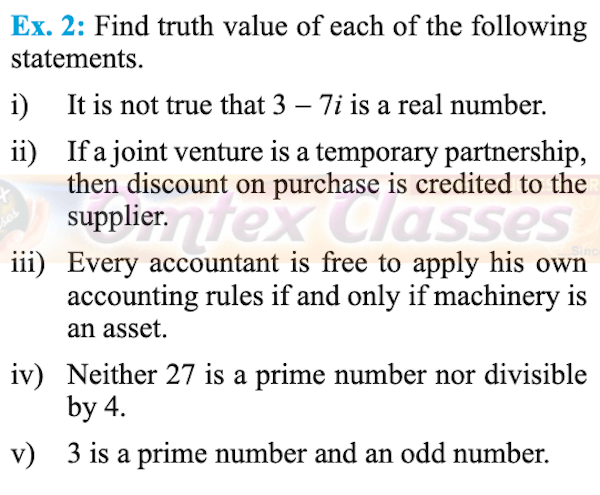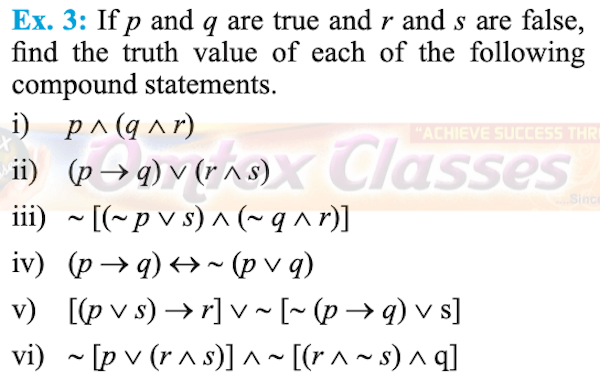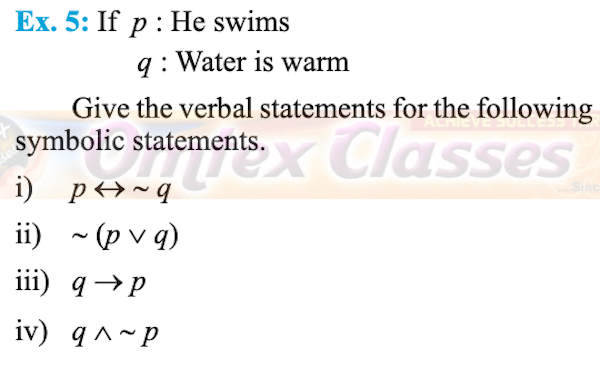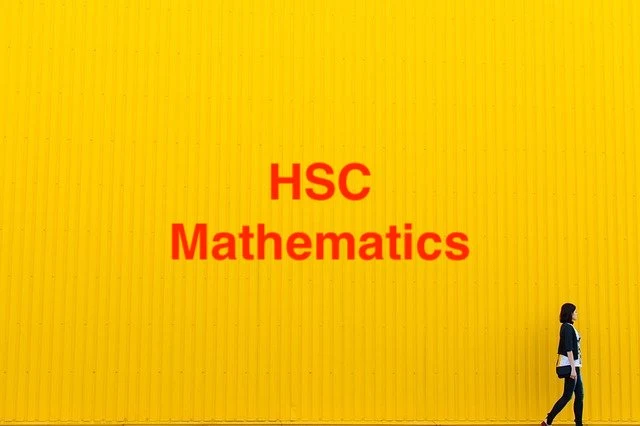Balbharati solutions for Mathematics and Statistics 1 (Commerce) 12th Standard HSC Maharashtra State Board Chapter 1 Mathematical Logic Exercise 1.4 [Pages 10 - 11]
Write the following statement in symbolic form.
If triangle is equilateral then it is equiangular.
SOLUTION
Let p : Triangle is equilateral.
q : Triangle is equiangular.
The symbolic form is p → q.
Write the following statement in symbolic form.
It is not true that “i” is a real number.
SOLUTION
Let p : i is a real number.
The symbolic form is ~ p.
Write the following statement in symbolic form.
Even though it is not cloudy, it is still raining.
SOLUTION
Let p : It is cloudy.
q : It is raining.
The symbolic form is ~p ∧ q.
Write the following statement in symbolic form.
Milk is white if and only if the sky is not blue.
SOLUTION
Let p : Milk is white.
q : Sky is blue.
The symbolic form is p ↔ ~ q.
Write the following statement in symbolic form.
Stock prices are high if and only if stocks are rising.
SOLUTION
Let p : Stock prices are high.
q : Stock are rising
The symbolic form is p ↔ q.
Write the following statement in symbolic form.
If Kutub-Minar is in Delhi then Taj-Mahal is in Agra.
SOLUTION
Let p : Kutub-Minar is in Delhi.
q : Taj-Mahal Is in Agra.
The symbolic form is p → q.
Find the truth value of the following statement.
It is not true that 3 − 7i is a real number.
SOLUTION
Let p : 3 – 7i is a real number.
The truth value of p is F.
The given statement in symbolic form is ~p.
∴ ~ p ≡ ~ F ≡ T
∴ Truth value of the given statement is T.
Find the truth value of the following statement.
If a joint venture is a temporary partnership, then discount on purchase is credited to the supplier.
SOLUTION
Let p : A joint venture is a temporary partnership. q : Discount on purchase is credited to the supplier.
The truth value of p and q are T and F respectively.
The given statement in symbolic form is p → q.
∴ p → q ≡ T → F ≡ F
∴ Truth value of the given statement is F.
Find the truth value of the following statement.
Every accountant is free to apply his own accounting rules if and only if machinery is an asset.
SOLUTION
Let p : Every accountant is free to apply his own accounting rules.
q : Machinery is an asset.
The truth values of p and q are F and T respectively.
The given statement in symbolic form is p ↔ q.
∴ p ↔ q ≡ F ↔ T ≡ F
∴ Truth value of the given statement is F.
Find the truth value of the following statement.
Neither 27 is a prime number nor divisible by 4.
SOLUTION
Let p : 27 is a prime number.
q : 27 is divisible by 4.
The truth values of p and q are F and F respectively.
The given statement in symbolic form is ~ p ∧ ~ q.
∴ ~ p ∧ ~ q ≡ ~ F ∧ ~ F ≡ T ∧ T ≡ T
∴ Truth value of the given statement is T.
Find the truth value of the following statement.
3 is a prime number and an odd number.
SOLUTION
Let p : 3 is a prime number.
q : 3 is an odd number.
The truth values of p and q are T and T respectively.
The given statement in symbolic form is p ∧ q.
∴ p ∧ q ≡ T ∧ T ≡ T
∴ Truth value of the given statement is T.
If p and q are true and r and s are false, find the truth value of the following compound statement.
p ∧ (q ∧ r)
SOLUTION
p ∧ (q ∧ r) ≡ T ∧ (T ∧ F)
≡ T ∧ F
≡ F
Hence, truth value if F.
If p and q are true and r and s are false, find the truth value of the following compound statement.
(p → q) ∨ (r ∧ s)
SOLUTION
(p → q) ∨ (r ∧ s) ≡ (T → T) ∨ (F ∧ F)
≡ T ∨ F
≡ T
Hence, truth value if T.
If p and q are true and r and s are false, find the truth value of the following compound statement.
~ [(~ p ∨ s) ∧ (~ q ∧ r)]
SOLUTION
~ [(~ p ∨ s) ∧ (~ q ∧ r)] ≡ ~[(~T ∨ F) ∧ (~T ∧ F)]
≡ ~[(F ∨ F) ∧ (F ∧ F)
≡ ~ (F ∧ F)
≡ ~ F
≡ T
Hence, truth value if T.
If p and q are true and r and s are false, find the truth value of the following compound statement.
(p → q) ↔ ~(p ∨ q)
SOLUTION
(p → q) ↔ ~(p ∨ q) ≡ (T → T) ↔ (T ∨ T)
≡ T ↔ ~ T
≡ T ↔ F
≡ F
Hence, truth value if F.
If p and q are true and r and s are false, find the truth value of the following compound statement.
[(p ∨ s) → r] ∨ ~ [~ (p → q) ∨ s]
SOLUTION
[(p ∨ s) → r] ∨ ~ [~ (p → q) ∨ s]
≡ [(T ∨ F) → F] ∨ ~[~ (T → T) ∨ F]
≡ (T → F) ∨ ~ (~ T ∨ F)
≡ F ∨ ~ (F ∨ F)
≡ F ∨ ~ F
≡ F ∨ T
≡ T
Hence, truth value is T.
If p and q are true and r and s are false, find the truth value of the following compound statement.
~ [p ∨ (r ∧ s)] ∧ ~ [(r ∧ ~ s) ∧ q]
SOLUTION
~ [p ∨ (r ∧ s)] ∧ ~ [(r ∧ ~ s) ∧ q]
≡ ~ [T ∨ (F ∧ F)] ∧ ~ [(F ∧ ~ F) ∧ T]
≡ ~ (T ∨ F) ∧ ~ [(F ∧ T) ∧ T]
≡ ~ T ∧ ~ (F ∧ T)
≡ F ∧ ~ F
≡ F ∧ T
≡ F
Hence, truth value is F.
Assuming that the following statement is true,
p : Sunday is holiday,
q : Ram does not study on holiday,
find the truth values of the following statements.
Sunday is not holiday or Ram studies on holiday.
SOLUTION
Symbolic form of the given statement is ~ p ∨~q
∴ ~ p ∨~ q ≡ ~ T ∨ ~ T
≡ F ∨ F
≡ F
Hence, truth value is F.
Assuming that the following statement is true,
p : Sunday is holiday,
q : Ram does not study on holiday,
find the truth values of the following statements.
If Sunday is not holiday then Ram studies on holiday.
SOLUTION
Symbolic form of the given statement is
~ p → ~ q
∴ ~ p → ~ q ≡ ~ T → ~ T
≡ F → F
≡ T
Hence, truth value is T.
Assuming that the following statement is true,
p : Sunday is holiday,
q : Ram does not study on holiday,
find the truth values of the following statements.
Sunday is a holiday and Ram studies on holiday.
SOLUTION
Symbolic form of the given statement is p ∧ ~ q
∴ p ∧ ~ q ≡ T ∧ ~ T
≡ T ∧ F
≡ F
Hence, truth value is F.
If p : He swims
q : Water is warm
Give the verbal statement for the following symbolic statement.
p ↔ ~ q
SOLUTION
He swims if and only if water is not warm.
If p : He swims
q : Water is warm
Give the verbal statement for the following symbolic statement.
~ (p ∨ q)
SOLUTION
It is not true that he swims or water is warm.
If p : He swims
q : Water is warm
Give the verbal statement for the following symbolic statement.
q → p
SOLUTION
If water is warm then he swims.
If p : He swims
q : Water is warm
Give the verbal statement for the following symbolic statement.
q ∧ ~ p
SOLUTION
Water is warm and he does not swim.





